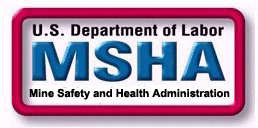
|
MSHA's Occupational Illness and Injury Prevention Program Health Topic "Working in Confined Spaces" |  |
|---|
A confined space is defined as any space or structure which by design has limited openings for entry and exit, and which is not intended for continuous employee occupancy. A confined space has poor natural ventilation. Confined spaces include storage tanks,pits, silos, vats, boilers ducts sewers, pipelines, and other structures found at metal/nonmetal mines. A confined space which is immediately dangerous to life or health (IDLH) includes those with oxygen deficiency, explosive or flammable atmospheres, or high concentrations of toxic substances - and requires the most demanding protective measures. Any operation which generates toxic contaminants within a confined space, without proper control measures and precautions, may be dangerous to lifewithin a short period of time.
When work is planned within a confined space, the supervisor and the miner who is to carry out the work should have an understanding as to the work to be done, the hazards that may arise, and the necessary protective measures to be taken. A work permit which contains this information in writing is highly recommended. This will provide authorization for the work, and requires that the supervisor and employee review the operation, hazards and control measures before entry and before the operation is started.
Protective and precautionary measures for work in confined spaces should involve as a minimum, the following:
1. Atmospheric testing and monitoring. Prior toentry, initial testing of the atmosphere should be carried out from the outside. Such tests should include those for oxygen content, flammability, and toxic contaminants. In accord with MSHA regulations, the oxygen content shall be at least 19.5%. If it appears that an atmosphere immediately dangerous to life may develop, it is essential that a safety belt or harness and a life line be worn by the person in the confined space. A standby person must be in attendance.
2. Training of personnel. Employees who are to work in confined spaces should be adequately trained. Such training should include understanding of the hazards involved, entry and exit procedures, safety equipment, emergency first aid, control measures such as ventilation, use of appropriate respirators if required, and proper work practices.
3. Standby person. When work is conducted within a confined space, a standby person should be stationed on the outside. This person should be trained in emergency rescue and first-aid procedures, and should have communication equipment as necessary for contact with those working inside, and for immediate contact with medical, ambulance, fire fighting, and other rescue personnel if needed. MSHA regulations require that such person be present if the atmosphere in the confined space is dangerous (IDLH). The standby person should be familiar with and have available appropriate respiratory protection equipment.
4. Safety equipment and clothing. Employees working in confined spaces must have available and use appropriate safety equipment and clothing - such as eye and face protection, proper gloves and full-coverage work clothing where indicated, and safety belt or harness with lifeline in dangerous atmospheres. MSHA regulations have specific requirements for such safety equipment and clothing. Hearing protection in the form of ear plugs or muffs is required where noise levels exceed MSHA standards. Personal respiratory protection may be necessary if ventilation is not sufficient to control contaminants to the permissible exposure limits. This may be in the form of supplied-air respirators or self-contained breathing apparatus and is recommended where contaminants from welding, painting, solvent cleaning or other operations generating toxic contaminants are involved.
5. Warning signs. Warning signs of a confined space and the hazard should be posted near entrances. When work is not in progress, the entrance should be blocked. When work is inprogress, the standby person should ensure that unauthorized persons do not enter the restricted area.
6. Purging and ventilation. Purging of the confined space to remove contaminants should be done before entry by means of a high rate of general ventilation. Atmospheric testing is then in order. Atmospheric testing is then in order. The main environmental, or engineering, control of suspected or known contaminants during operations is general ventilation. Design of the system will vary. Continuous general ventilation is recommended for most operations where contaminants are generated. This may be supplemented or replaced by local exhaust ventilation. Personal respiratory protection may be required in addition to general and/or local exhaust ventilation. Monitoring of contaminants during operations is indicated if there is doubt about the effectiveness of controls.
Attention to the protective and precautionary measures outlined above is essential for assurance that exposures within confinedspaces are controlled.
If you have any questions about this or any other occupational health matter, feel free to ask us. Our job is protecting your health.Contact:
Mine Safety and Health Administration
Metal and Nonmetal Health Division
1100 Wilson Boulevard
Arlington, Virginia 22209-3939
Phone: (202) 693-9630